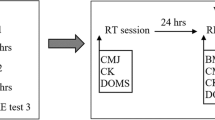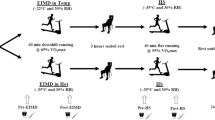Abstract
Purpose
Exercise-induced muscle damage (EIMD) has recently been shown to increase heat strain during exercise heat stress (HS), and represents a risk factor for exertional heat illness (EHI). We hypothesised that a repeated bout of EIMD blunts the increase in rectal temperature (T re) during subsequent endurance exercise in the heat.
Methods
Sixteen non-heat-acclimated males were randomly allocated to EIMD (n = 9) or control (CON, n = 7). EIMD performed a downhill running treatment at −10 % gradient for 60 min at 65 % \(\mathop V\limits^{.}\)O2max in 20 °C, 40 % RH. CON participants performed the same treatment but at +1 % gradient. Following treatment, participants rested for 30 min, then performed HS (+1 % gradient running for 40 min at 65 % \(\mathop V\limits^{.}\)O2max in 33 °C, 50 % RH) during which thermoregulatory measures were assessed. Both groups repeated the treatment and subsequent HS 14 days later. Isometric quadriceps strength was assessed at baseline, and 48 h post-treatment.
Results
The decrease in leg strength 48 h post-EIMD trial 1 (−7.5 %) was absent 48 h post-EIMD trial 2 (+2.9 %) demonstrating a repeated bout effect. Final T re during HS was lower following EIMD trial 2 (39.25 ± 0.47 °C) compared with EIMD trial 1 (39.59 ± 0.49 °C, P < 0.01), with CON showing no difference. Thermal sensation and the T re threshold for sweating onset were also lower during HS on EIMD trial 2.
Conclusion
The repeated bout effect blunted the increase in heat strain during HS conducted after EIMD. Incorporating a muscle-damaging bout into training could be a strategy to reduce the risk of EHI and improve endurance performance in individuals undertaking heavy exercise with an eccentric component in the heat.






Similar content being viewed by others
Abbreviations
- CON:
-
Control group
- eHsp72:
-
Extracellular heat-shock protein 72
- EIMD:
-
Exercise-induced muscle damage
- HR:
-
Heart rate
- HS:
-
Exercise heat stress test
- Hsp:
-
Heat-shock protein
- IL:
-
Interleukin
- M:
-
Metabolic energy expenditure
- NBM:
-
Nude body mass
- RER:
-
Respiratory exchange ratio
- RH:
-
Relative humidity
- RPE:
-
Rating of perceived exertion
- TNF:
-
Tumour necrosis factor
- T re :
-
Rectal core temperature
- T sk :
-
Skin temperature
- VO2max :
-
Maximal oxygen uptake
- WURSS:
-
Wisconsin upper respiratory symptom survey
References
Armstrong LE, Casa DJ, Millard-Stafford M, Moran DS, Pyne SW, Roberts WO (2007) American College of Sports Medicine position stand. Exertional heat illness during training and competition. Med Sci Sports Exerc 39:556–572
Armstrong LE, Pumerantz AC, Fiala KA, Roti MW, Kavouras SA, Casa DJ, Maresh CM (2010) Human hydration indices: acute and longitudinal reference values. Int J Sport Nutr Exerc Metab 20:145–153
Asea A, Kraeft SK, Kurt-Jones EA, Stevenson MA, Chen LB, Finberg RW, Koo GC, Calderwood SK (2000) HSP70 stimulates cytokine production through a CD14-dependant pathway, demonstrating its dual role as a chaperone and cytokine. Nat Med 6:435–442
Barnett A, Maughan RJ (1993) Response of unacclimatized males to repeated weekly bouts of exercise in the heat. Br J Sports Med 27:39–44
Barrett B, Locken K, Maberry R, Schwamman J, Brown R, Bobula J, Stauffacher EA (2002) The Wisconsin Upper Respiratory Symptom Survey (WURSS): a new research instrument for assessing the common cold. J Fam Pract 51:265
Borg GA (1982) Psychophysical bases of perceived exertion. Med Sci Sports Exerc 14:377–381
Bouchama A (1995) Heatstroke: a new look at an ancient disease. Intensive Care Med 21:623–625
Braun WA, Dutto DJ (2003) The effects of a single bout of downhill running and ensuing delayed onset of muscle soreness on running economy performed 48 h later. Eur J Appl Physiol 90:29–34
Bruunsgaard H, Galbo H, Halkjaer-Kristensen J, Johansen TL, MacLean DA, Pedersen BK (1997) Exercise-induced increase in serum interleukin-6 in humans is related to muscle damage. J Physiol 499:833–841
Buettner KJ (1959) Diffusion of water vapor through small areas of human skin in normal environment. J Appl Physiol 14:259–275
Byrnes WC, Clarkson PM, White JS, Hsieh SS, Frykman PN, Maughan RJ (1985) Delayed onset muscle soreness following repeated bouts of downhill running. J Appl Physiol 59:710–715
Carter R III, Cheuvront SN, Williams JO, Kolka MA, Stephenson LA, Sawka MN, Amoroso PJ (2005) Epidemiology of hospitalizations and deaths from heat illness in soldiers. Med Sci Sports Exerc 37:1338–1344
Casa DJ, Armstrong LE, Kenny GP, O’Connor FG, Huggins RA (2012) Exertional heat stroke: new concepts regarding cause and care. Curr Sports Med Rep 11:115–123
Clarkson PM, Hubal MJ (2002) Exercise-induced muscle damage in humans. Am J Phys Med Rehabil 81:S52–S69
Clarkson PM, Nosaka K, Braun B (1992) Muscle function after exercise-induced muscle damage and rapid adaptation. Med Sci Sports Exerc 24:512–520
Cluver EH (1932) An analysis of ninety-two fatal heat-stroke cases on the Witwatersrand gold mines. S Afr Med J 6:19–22
Croisier JL, Camus G, Venneman I, Deby-Dupont G, Juchmes-Ferir A, Lamy M, Crielaard JM, Deby C, Duchateau J (1999) Effects of training on exercise-induced muscle damage and interleukin 6 production. Muscle Nerve 22:208–212
DeMartini JK, Casa DJ, Belval LN, Crago A, Davis RJ, Jardine JJ, Stearns RL (2014) Environmental conditions and the occurrence of exertional heat illnesses and exertional heat stroke at the Falmouth road race. J Athl Train 49:478–485
Dill DB, Costill DL (1974) Calculation of percentage changes in volumes of blood, plasma, and red cells in dehydration. J Appl Physiol 37:247–248
Epstein Y, Moran DS, Shapiro Y, Sohar E, Shemer J (1999) Exertional heat stroke: a case series. Med Sci Sports Exerc 31:224–228
Fehrenbach E, Niess AM, Voelker K, Northoff H, Mooren FC (2005) Exercise intensity and duration affect blood soluble HSP72. Int J Sports Med 26:552–557
Fortes MB, Di FU, Dolci A, Junglee NA, Crockford MJ, West L, Hillier-Smith R, Macdonald JH, Walsh NP (2013) Muscle-damaging exercise increases heat strain during subsequent exercise heat stress. Med Sci Sports Exerc 45:1915–1924
Garrett AT, Goosens NG, Rehrer NJ, Patterson MJ, Cotter JD (2009) Induction and decay of short-term heat acclimation. Eur J Appl Physiol 107:659–670
Gonzalez-Alonso J, Teller C, Andersen SL, Jensen FB, Hyldig T, Nielsen B (1999) Influence of body temperature on the development of fatigue during prolonged exercise in the heat. J Appl Physiol 86:1032–1039
Hollies NRS, Goldman RFG (1977) Psychological scaling in comfort assessment. In: Hollies NRS, Goldman RFG (eds) Clothing comfort: interaction of thermal, ventilation, construction, and assessment factors. Ann Arbor Science Publishers, Ann Arbor, pp 107–120
Horowitz M (2014) Heat acclimation, epigenetics, and cytoprotection memory. Compr Physiol 4:199–230
Horowitz M, Robinson SD (2007) Heat shock proteins and the heat shock response during hyperthermia and its modulation by altered physiological conditions. Prog Brain Res 162:433–446
Kuennen M, Gillum T, Dokladny K, Bedrick E, Schneider S, Moseley P (2011) Thermotolerance and heat acclimation may share a common mechanism in humans. Am J Physiol Regul Integr Comp Physiol 301:R524–R533
Lim CL, Mackinnon LT (2006) The roles of exercise-induced immune system disturbances in the pathology of heat stroke: the dual pathway model of heat stroke. Sports Med 36:39–64
McHugh MP, Connolly DA, Eston RG, Gleim GW (1999) Exercise-induced muscle damage and potential mechanisms for the repeated bout effect. Sports Med 27:157–170
Montain SJ, Latzka WA, Sawka MN (2000) Impact of muscle injury and accompanying inflammatory response on thermoregulation during exercise in the heat. J Appl Physiol 89:1123–1130
Moore JP, Harper Smith AD, Di Felice U, Walsh NP (2013) Three nights of sleep deprivation does not alter thermal strain during exercise in the heat. Eur J Appl Physiol 113:2353–2360
Moran DS, Shitzer A, Pandolf KB (1998) A physiological strain index to evaluate heat stress. Am J Physiol 275:R129–R134
Moran DS, Eli-Berchoer L, Heled Y, Mendel L, Schocina M, Horowitz M (2006) Heat intolerance: does gene transcription contribute? J Appl Physiol 100:1370–1376
Nieman DC, Henson DA, Smith LL, Utter AC, Vinci DM, Davis JM, Kaminsky DE, Shute M (2001) Cytokine changes after a marathon race. J Appl Physiol 91:109–114
Nishi Y (1981) Measurement of thermal balance in man. In: Cena K, Clark JA (eds) Bioengineering, thermal physiology and comfort. Elsevier, New York, pp 29–39
O’Reilly KP, Warhol MJ, Fielding RA, Frontera WR, Meredith CN, Evans WJ (1987) Eccentric exercise-induced muscle damage impairs muscle glycogen repletion. J Appl Physiol 63:252–256
Pastukhov I, Ekimova IV, Guzhova IV (2003) Major stress protein has pyrogenic action. Dokl Biol Sci 388:41–44
Paulsen G, Lauritzen F, Bayer ML, Kalhovde JM, Ugelstad I, Owe SG, Hallen J, Bergersen LH, Raastad T (2009) Subcellular movement and expression of HSP27, alphaB-crystallin, and HSP70 after two bouts of eccentric exercise in humans. J Appl Physiol 107:570–582
Peake JM, Suzuki K, Hordern M, Wilson G, Nosaka K, Coombes JS (2005) Plasma cytokine changes in relation to exercise intensity and muscle damage. Eur J Appl Physiol 95:514–521
Pizza FX, Davis BH, Henrickson SD, Mitchell JB, Pace JF, Bigelow N, DiLauro P, Naglieri T (1996) Adaptation to eccentric exercise: effect on CD64 and CD11b/CD18 expression. J Appl Physiol 80:47–55
Ramanathan NL (1964) A new weighting system for mean surface temperature of the human body. J Appl Physiol 19:531–533
Rav-Acha M, Hadad E, Epstein Y, Heled Y, Moran DS (2004) Fatal exertional heat stroke: a case series. Am J Med Sci 328:84–87
Sawka MN, Leon LR, Montain SJ, Sonna LA (2011) Integrated physiological mechanisms of exercise performance, adaptation, and maladaptation to heat stress. Compr Physiol 1:1883–1928
Shephard RJ, Shek PN (1999) Immune dysfunction as a factor in heat illness. Crit Rev Immunol 19:285–302
Smith LL, McKune AJ, Semple SJ, Sibanda E, Steel H, Anderson R (2007) Changes in serum cytokines after repeated bouts of downhill running. Appl Physiol Nutr Metab 32:233–240
Thompson HS, Scordilis SP, Clarkson PM, Lohrer WA (2001) A single bout of eccentric exercise increases HSP27 and HSC/HSP70 in human skeletal muscle. Acta Physiol Scand 171:187–193
Vickers AJ (2001) Time course of muscle soreness following different types of exercise. BMC Musculoskelet Disord 2:5
Walsh NP, Gleeson M, Pyne DB, Nieman DC, Dhabhar FS, Shephard RJ, Oliver SJ, Bermon S, Kajeniene A (2011) Position statement. Part two: maintaining immune health. Exerc Immunol Rev 17:64–103
Warren GL III, Williams JH, Ward CW, Matoba H, Ingalls CP, Hermann KM, Armstrong RB (1996) Decreased contraction economy in mouse EDL muscle injured by eccentric contractions. J Appl Physiol 81:2555–2564
Whitham M, Fortes MB (2008) Heat shock protein 72: release and biological significance during exercise. Front Biosci 13:1328–1339
Willoughby DS, McFarlin B, Bois C (2003) Interleukin-6 expression after repeated bouts of eccentric exercise. Int J Sports Med 24:15–21
Acknowledgments
We would like to thank the following people for their valuable assistance with data collection: Robert Blake, Emily Hogarth, Debra Larmett and Mike Urquhart. We are also indebted to the participants for their time and co-operation. This study received no external funding.
Author information
Authors and Affiliations
Corresponding author
Additional information
Communicated by Narihiko Kondo.
Rights and permissions
About this article
Cite this article
Dolci, A., Fortes, M.B., Walker, F.S. et al. Repeated muscle damage blunts the increase in heat strain during subsequent exercise heat stress. Eur J Appl Physiol 115, 1577–1588 (2015). https://doi.org/10.1007/s00421-015-3143-7
Received:
Accepted:
Published:
Issue Date:
DOI: https://doi.org/10.1007/s00421-015-3143-7




